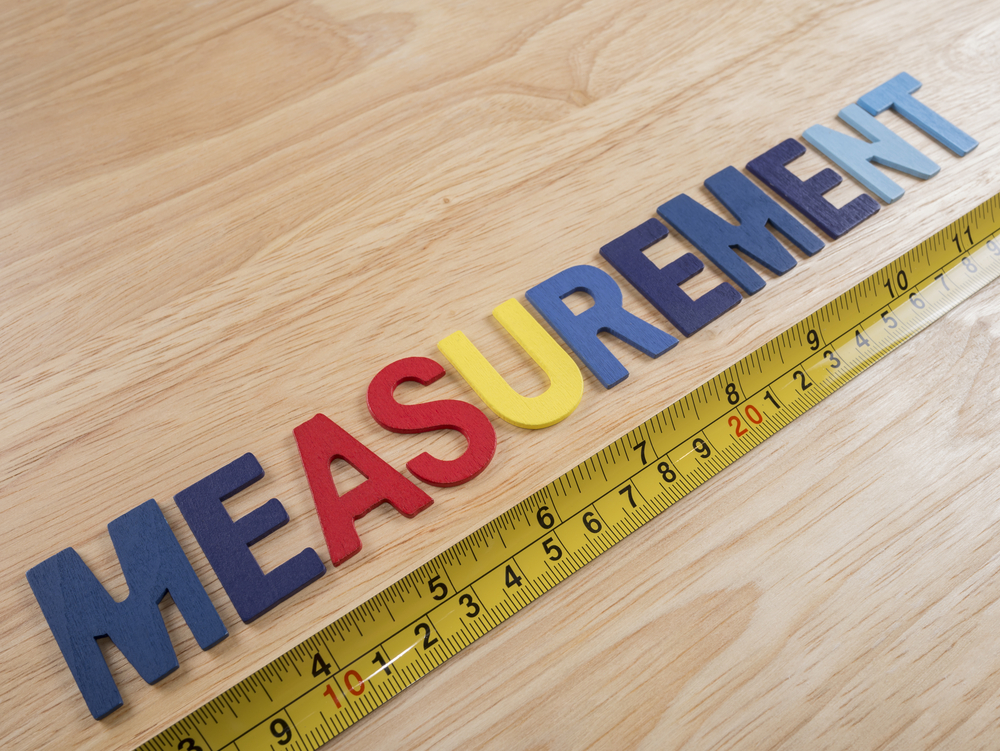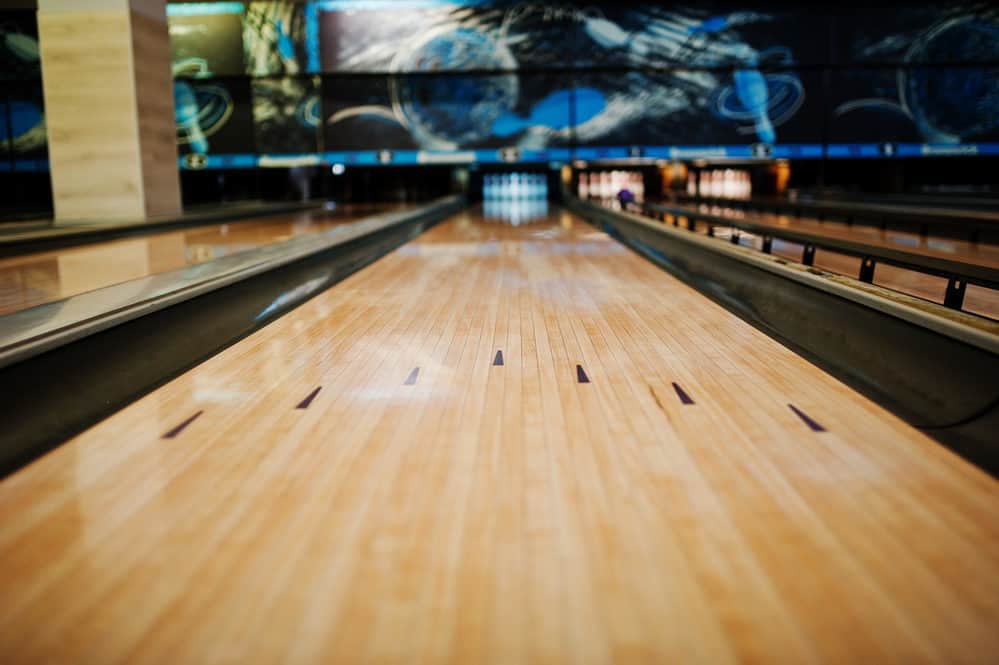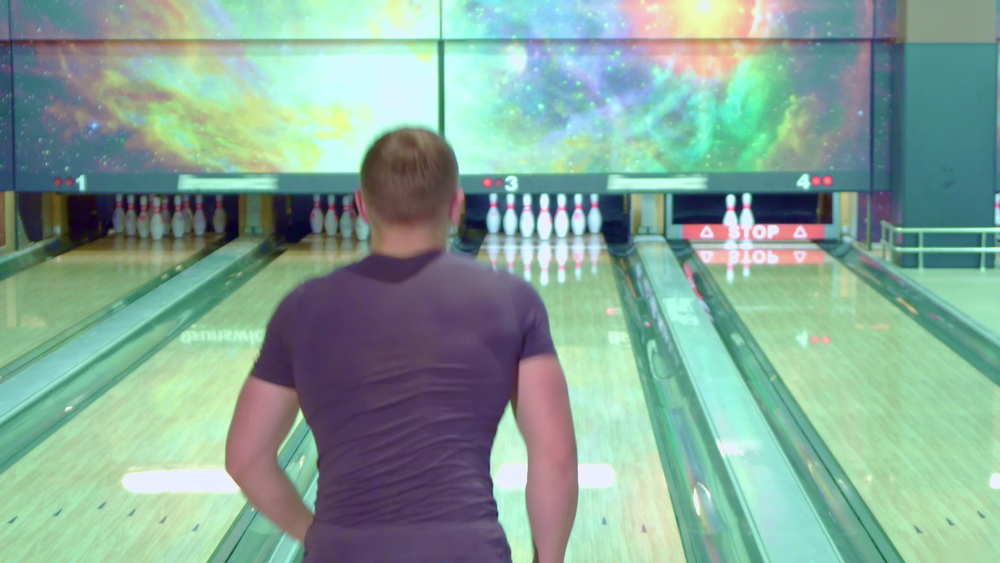
You walk to the bowling approach area and release the bowling ball. The bowling ball is rolling down the lane surface, over and over it spins as it makes its way towards the beckoning head pin.
You hold your breath in apprehension, why does this always seem to take so long?
How much longer until your ball makes contact with the bowling pins? How many will you get?
Your trusty bowling ball finally crashes into the head pin and you let out a breath followed by an excited whoop as 10 pins fall following your excellent throw.
An ‘x’ appears on your screen and you give a quick grin of triumph, high-fiving your fellow bowlers as you go to sit down until it’s your turn to hopefully score more points.
As you watch the next bowler line up and get ready to approach you can’t help but wonder, just how long are these bowling lanes? What you are really curious about are the bowling lane dimensions.
If you are new to the bowling world or perhaps you just have never taken the time to stop and really think about the rules and regulations that go into a regulation lane, you have come to the right place!
On this page, we plan to discuss the contents bowling lane dimensions, the makeup of the lane, as well as other regulations or information we feel is important for you to know as a bowler.
Because, let’s be honest, without a bowling lane the game of bowling would be a whole lot different!
Contents
Bowling Lane Dimensions

What are the dimensions of a bowling alley lane? When you are looking at a bowling lane you will notice that the shape of the lane turns out to be a long, skinny version of a rectangle.
This is because the width of each individual lane sits at 3 feet and 6 inches while the length of the lane happens to be a whopping 60 feet long.
The width is measured from gutter tip to gutter tip while the length starts at the foul line and ends at the head pin.
This means that the area where the pins are sitting and anything behind the pins does not count towards the length of the lane, although the parts can be uniform in appearance.
Key Takeaways
- Bowling Lane Dimensions: Regulation bowling lanes are 60 feet long and 3 feet 6 inches wide, measured from the foul line to the head pin, excluding the pin deck and approach area. This rectangular shape aids players in strategizing their play.
- Lane Composition and Boards: Lanes consist of 39 wooden boards, divided into three sections with distinct materials — the approach area and beginning of the lane feature maple, transitioning to pine, and ending again with maple at the pin deck, enhancing the ball's trajectory and spin.
- Foul Line Importance: The foul line marks the start of the bowling lane; crossing it during a delivery counts as a foul. Sensors near the line help enforce this rule, promoting fair play and precision in the game.
- Gutters and Scoring: Gutters run alongside the lane for its entire length, capturing balls that veer off, leading to a score of zero for that throw. Understanding their placement helps players adjust their aim and strategy.
- Targeting with Markings: Dots, arrows, and range markers along the lane assist bowlers in aligning their shots. These visual aids are crucial for achieving desired ball trajectories and improving scores.
What Are the Parts of a Bowling Lane?

While many people see the bowling lane as one solidified object what they fail to realize is that the lane is actually broken up into several parts.
Each part contributes to the lane as a whole, but they each have their own role to play in the rules of bowling.
There are also other parts of a bowling alley, that are connected to the lane in some way, that play an important part in the game of bowling. However, those pieces are not included in the dimensions mentioned above.
Bowling Lane Boards
Every bowling lane (nine pin bowling, ten pin bowling, candlepin bowling, duckpin bowling, and five pin bowling) is made up of 39 boards that are about one inch wide, with the center board being marked by board number 20.
The boards are usually made out of wood, and while the lane looks to be one whole part, it is actually broken up into three parts.
- The first section starts at the foul line and goes out 12 feet into the lane, this section is made up of maple.
- The second section then goes from the 12-foot mark to the head pin (so 46 feet) and is made up of pine.
- Where the pins stand is then made up of maple once more, finishing up the wooden floor of the alley lane.
What is the Foul Line?
The foul line of a bowling lane can be found at the very start of the lane, painted across the boards of the lane and sitting between the two gutters.
The purpose of the foul line is to indicate when a bowler has gone too far with their approach and has, in essence, fouled. A foul occurs when the bowling crosses the foul line.
In order to foul any physical part of the bowler, usually, a foot must physically touch the floorboards past the foul line.
There are usually sensors connected to the foul line that are then triggered to either make lights flash or make a series of alarms sound, startling everyone on your lane.
What Are Gutters in Bowling?
On each side of the bowling lane sits a gutter, a dipped trench that is usually made out of rubber or plastic.
The gutters are 60 feet long as well. When a bowling ball goes off the wooden part of the lane it falls into the gutter and is considered a miss for that throw, resulting in no points added to the current score.
Many groans of frustration and bargaining prayers have been uttered due to gutters, yet for some reason, most of them go unheard.
What Is the Head Pin in Bowling?
The head pin, also called the "one pin" or "pin one", sits at the very front of the pyramid formation of pins, exactly 60 feet from the foul line. Used as a marker for the 60-foot lane, the head pin signals where the lane ends, and the bowling wall begins.
The Bowling Wall
The bowling wall is usually marked by advertisements or colorful bowling pictures that remind you of Alice in Wonderland. The bowling wall sits at the end of the 60-foot lane and houses the floor where the pins sit as well as the bowling machine.

The Bowling Machine
The bowling pinsetter machine is perhaps one of the most important pieces of bowling equipment in the alley, since it retrieves the ball and sends it back to the bowler as well as clears and rearranges the pins.
Before the invention of the bowling machine, people, usually part-timers looking to earn a little cash, would sit hidden at the end of the lane and at the end of each turn, adjust the pins and retrieve the ball.
Thanks to the bowling machine, the process has been refined and sped up, resulting in quicker resets and faster games.
The Approach Area
The approach area is a wooden area that is 15 feet in length, ending at the foul line. This is the area where bowlers adjust their stance, figure out their timing, and mentally prep before each throw.
Dots located on the wooden boards help bowlers keep track of where they stand in order to adjust their timing with their throws.
The machine where balls come out of after retrieval is also located in this area, back towards the end of the 15 feet and to either the left or right side of the lane to give bowlers plenty of room to pace themselves before a throw.
Bowling Lane Targeting: Dots, Arrows and Range Markers
If you look down onto the lane, you will notice a variety of dots, arrows, and range markers decorating the wooden planks at varying distances.
These markings are there to help bowlers with their targeting. Each bowler bowls in a different way.
Their posture or stance could be different, the way the throw could change their trajectory, or the timing of their release can shift their ball. This is where the markings come in.
By using these markings, bowlers are able to find the basic range in where they want to throw their ball to get it on the right trajectory.
By watching either one or two sets of targets and how the ball rolls by them, most bowlers are able to make adjustments and alignments based on the results of their throws.
This helps immensely when bowlers are traveling to unfamiliar lanes and are able to use the dots to find their basic range before modifying their alignment as needed.
Types of Targeting Marks
As we mentioned before, there are three basic types of markings found on each lane, dots, arrows, and ranger markers. These symbols are spread apart to help with targeting and can be found in different areas of the lane.
Approach Dots
These dots are not actually found on the lane but rather in 15-foot long Approach area just before the lane.
There are three different sets of dots in the Approach area and they are usually 5 or 7 dots wide.
In the center you will always find a dot bigger than the others, this dot is always placed on board number 20 and will line up with the center of the lane and the head pin.
These sets of dots are placed in this manner to help bowlers have a reference point for where to place their feet for their chosen stance.
This is incredibly important since the starting point of the bowler as well as their stance affects the starting angle of the ball.
Lane Dots
While lane dots can vary from bowling alley to bowling alley they are generally found just before the foul line. Sometimes two sets of 5 dots, one from the left and one from the right, can also be found just across the foul line.
The gaps between the sets of dots can also be used as a reference point. These lane dots are used like all the other markings, as reference guides for trajectory and alignment.
Arrows
These arrow-shaped markings are found at the 15-foot mark of the lane in an upside down ‘V’ formation, with the foremost arrow sitting at the center and the closest arrows being at the very edges of the ‘V'.
Many bowlers like to aim between the center arrow and it’s side counterparts in hopes of their trajectory resulting in a strike.
Just after the center arrow the pinewood section of the lane begins, it’s a subtle change in color also used as a marking by bowlers. Because of these factors, the arrows are the most commonly used targeting markings in bowling.
| Feature | Description | Material/Location |
|---|---|---|
| Overall Lane Length | 60 feet (from foul line to head pin, excluding pin deck) | N/A |
| Lane Width | 3 feet 6 inches (gutter to gutter) | N/A |
| Lane Composition | 39 wooden boards | Maple at the beginning and end, Pine in the middle |
| Foul Line | Marks the start of the bowling lane | Located at the lane's front, with sensors |
| Gutters | Capture off-target balls | Run along the lane's length, made of rubber/plastic |
| Bowling Pins | Set in an equilateral triangle | Placed at the lane's back end |
| Ball Return | Automated system to return balls | Alongside/under the lane |
| Markings (Dots, Arrows, Range Markers) | Aid in targeting and alignment | Located in the approach area and on the lane |
Range Markers
The range markers are actually darkened boards that are located further down the lane and close to the pins. While these boards are considered the ‘main’ target markers, not many bowlers take advantage of their use.
Lane Maintenance
In order to keep the lane well maintained there are several things that all bowlers need to know.
Every bowler uses at least one or two lanes during their time at a bowling alley and because of this, they need to take proper steps to be respectful of the owner’s property and the experience of other patrons.
Food and Drink
Never take food or drink out onto the approaching area of the lanes of the bowling alley. The lane has been well oiled by the owner, usually the night before, to help with the glide of bowler approaches and to maintain the health of the wood.
By bringing food onto the lane you are risking the fall of pesky crumbs and sticky spices which could build-up on the wooden planks and wreck your experience or a fellow bowler’s experience.
Bowling Shoes
Make sure to always wear bowling shoes, either rental or your own, when you are playing a game of bowling.
Regular shoes are not built for the slipperiness of the lanes, can cause serious injury to bowlers, and can track in dirt and debris that could scratch up and damage the lanes as well.
If you own a pair of bowling shoes, you should never wear them for everyday use or outside. Only use bowling shoes for bowling.
This is because, once again, dirt and debris can get stuck in the shoe, scratching up the lane and damaging its protective layer of oil.
Bowling Balls
While many serious bowlers possess their own personal bowling balls, a lot of leagues and low-key players take advantage of the bowling balls located in the bowling alley. These bowling balls, which are available for customer use, are known as house balls.
Sometimes bowlers will even use more than one ball during the course of their games in an effort to find the weight that works best for them. This, of course, is fine but what bowlers need to remember to always do is put their balls back on the shelves they took them from after they have finished using them.
This way the ball holding machine does not become full and is ready for use for the next bowler who happens to rent the lane.
It also helps keep the bowling alley neat and tidy for all patrons and shows that bowlers have enough maturity to pick up after themselves like adults.
Related Articles
So the next time you are bowling and you find yourself wondering about the dimensions of the lane once more, you now have your answers.
My Final Words
With its roots possibly stretching back to ancient Egypt, the sport of bowling has evolved significantly, culminating in the first standardized rules that shape every aspect of the game today. The overall length of a regulation lane, not including the settee area and ball return, emphasizes precision and skill. With a lane width of 3 feet 6 inches at its widest point, players must master the art of targeting, using the service aisle and lane markings to their advantage.
The arrangement of pins in an equilateral triangle at the back end, combined with the strategic use of the foul line and gutters, tests a bowler's ability to hit the sweet spot for strikes. Modern enhancements like the automated ball return further streamline the experience, allowing players to focus on improving their game. Understanding these components—the lane width, the tail plank's position, and the significance of each marked area—offers a direct path to mastering this revered sport, from the first set of pins to the last.
Kira Byrd, a Certified Fraud Examiner, holds a B.S. in Accounting from the University of Alabama at Birmingham. With a passion for bowling from her childhood, Kira has poured her expertise and personal experiences into creating and nurturing Bowling For Beginners. Kira's mission is to meet new bowlers where they are and guide them toward consistently achieving higher scores. With a focus on skill development and strategic techniques, she empowers readers to take control of their game and unlock their true potential.
Bowling For Beginners embodies strict editorial integrity, ensuring reliable and unbiased information. Kira's commitment to delivering valuable insights and practical strategies is reflected in every article. Here's an explanation of our editorial policy and how we get money.





